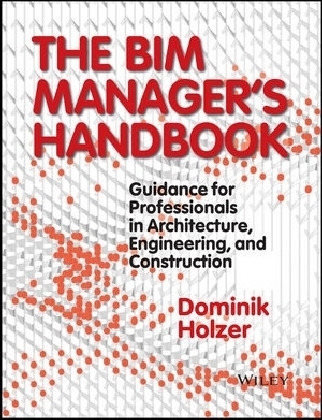
The BIM Manager's Handbook
John Wiley & Sons Inc (Verlag)
978-1-118-98242-6 (ISBN)
The BIM Manager's Handbook: Guidance for Professionals in Architecture, Engineering, and Construction
Building Information Modelling (BIM) is a design and construction software that manages not just graphics, but also information—information that enables the automatic generation of drawings and reports, design analysis, schedule simulation, facilities management, and cost analysis—ultimately enabling any building team to make better-informed decisions. This allows a range of professionals—architects, engineers, construction managers, surveyors, cost estimators, project managers, and facility managers—to share this information throughout a building's lifecycle. BIM is now recognized worldwide for the efficiencies it delivers in terms of working collaboratively, communication, processes, cost savings, and a property's lifecycle management.
With the widespread adoption of BIM, BIM Managers have become a much-needed new breed of professionals in architectural, engineering, and construction practice. Their role is often misunderstood and ill-defined, and such are the day-to-day deliverables that they are likely to face. The BIM Manager's Handbook provides an in-depth account of the breadth of activities that any BIM Manager or staff member, who is actively engaged in the delivery of project, is required to undertake.
Providing prereleases of the final work, The BIM Manager's Handbook ePart series isolates significant topics around BIM management. In the sixth and final ePart, BIM is taken to the next level by outlining what is required to truly excel as a BIM Manager. It highlights how BIM Managers acquire the necessary communication skills to maximize an efficient information flow between the BIM Manager and others. It illustrates how BIM Managers tie their activities to cutting-edge BIM research and development globally. Lastly, this ePart lays out how to promote BIM excellence both within an organization and beyond.
Dominik Holzer is a leading BIM expert, consulting with design and construction firms in Australia. He is the previous chair of the BIM and IPD Steering Group of the Australian Institute of Architecture and Consult Australia. He is Senior Lecturer in Digital Architecture at the University of Melbourne. Holzer frequently publishes on Design Technology, particularly BIM, and he is a regular speaker/host at high level industry conferences.
Acknowledgements ix Introduction Why BIM Managers Count! 1
The BIM Manager: Focus on the Person behind the Title 2
Hands-On BIM 6
Revelations and Surprises 8
Chapter 1 Best Practice BIM 11
BIM Managers: Breaking Ground 12
The Rise and Rise of BIM 13
Defining Good, or Even “Best Practice,” BIM 17
When BIM Goes Wrong — Examples of “Bad BIM” 22
The Tipping Point — How Do You Become Successful Using BIM? 29
Benchmarking BIM 35
Chapter 2 Change Management 43
Technology as a Driver for Innovation and Change 45
The Cultural Dimension of Change . . . and Its Management 47
Interfacing with Your Organization’s Leadership and Management 50
Overcoming Change Resistance and Managing Expectations 57
Tips and Tricks 67
Chapter 3 Focus on Technology 77
Interfacing Design Technology with Information Technology 79
Hardware/Software License Selection for BIM 81
Sharing BIM via Networks 83
BIM in the Cloud 85
Explaining Tool Ecologies 88
Interfacing BIM 92
Future Developments 109
Chapter 4 Building Up a BIM Support Infrastructure 113
Propagating BIM 115
Starting with the End in Mind—Employer Information Requirements 117
Setting the (BIM) Standards 121
BIM Execution Plans 125
The BIM Placemat 128
The BIM Capability Statement 130
BIM Library Management 133
Reaching Out 144
Chapter 5 Day-to-Day BIM Management 147
The Broad Spectrum of BIM 149
Advancing BIM Strategically 151
Planning BIM on a Project 157
Fire-Fighting and Lending a Helping Hand 171
Chapter 6 Excelling Your BIM Efforts 175
In Search of BIM Excellence 177
Becoming a BIM Expert 179
Innovating with BIM and Educating Others 181
BIM Research 185
Reaching Out and Getting Noticed! 188
Distinguishing Your Service Offering via BIM 193
Embracing Lifecycle BIM 196
Working According to Local Guidelines and Standards 198
Moving Forward (While Catching Up) 201
Epilogue 207
Index 209
| Verlagsort | New York |
|---|---|
| Sprache | englisch |
| Maße | 196 x 254 mm |
| Gewicht | 930 g |
| Themenwelt | Informatik ► Office Programme ► Outlook |
| Technik ► Architektur | |
| Technik ► Bauwesen | |
| ISBN-10 | 1-118-98242-8 / 1118982428 |
| ISBN-13 | 978-1-118-98242-6 / 9781118982426 |
| Zustand | Neuware |
| Haben Sie eine Frage zum Produkt? |
aus dem Bereich


